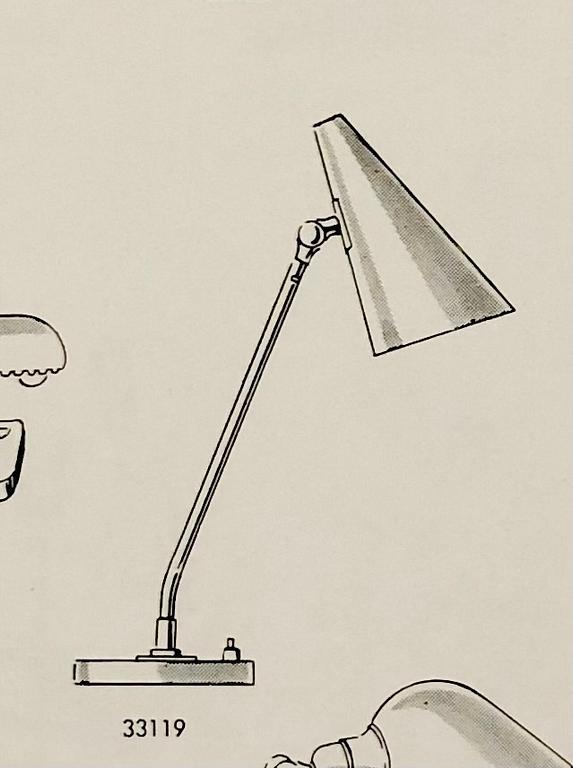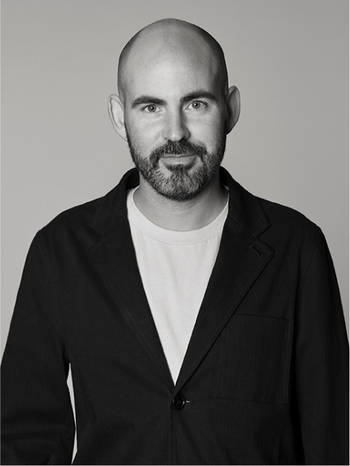Bertil Brisborg
Bertil Brisborg, Table lamps 1 pair, model "33119", Nordiska Kompaniet, 1950s.
Foot and shade in metal, lacquered in wine red, arm in brass, maker's mark NK 33119, height 50 cm.
Minor wear. New electricity.
Literature
Depicted in the Nordiska Kompaniets catalog in 1954, and archive 1955..
More information
A unique collection of lighting fixtures from Nordiska Kompaniet
Alongside Nordiska Kompaniet’s (NK) renowned furniture department led by Axel Einar Hjorth, there existed a thriving lighting department that is relatively unknown today. This fall, Bukowskis will share the story of NK’s lighting department, which held a prominent position during Sweden’s golden age of design from the 1920s to the 1950s. They created fixtures for various important interiors and exhibitions of the time. Nordiska Kompaniet is an integral part of Swedish design history. The brand was founded in 1902, and merely two years later, in 1904, NK’s factories were established in Nyköping. These factories played a pivotal role in the company’s success, contributing to the renowned quality that would define NK’s reputation. Employing around 500 workers, the factories became the largest industry in Nyköping. In NK’s factories, a wide range of fixtures, including custom-made and mass-produced options, were designed by the company’s leading lighting architects, including Erik Tidstrand, Bertil Brisborg, Olle Elmgren, and others. In addition to creating fixtures for department stores, they were also involved in prestigious interior design projects, producing lighting fixtures for significant locations like Stockholm City Hall, the Concert Hall, the American Line flagship M/S Kungsholm, Tändstickspalatset, as well as renowned restaurants, theaters, and cinemas. The collection being presented at Modern Art + Design spans from the 1920s to the 1950s and exemplifies distinctive styles of the era, such as Swedish Grace and Swedish Modern.
NK’s lighting department - a hidden treasure
NK’s lighting department quickly rose to become a pioneering fixtures company in Sweden, ushering in a new era of innovative designs and modern aesthetics. These fixtures were prominently displayed on the third floor, while a small workshop for manufacturing and assembly of lamps was also located within the department store. In the 1920s, Nordiska Kompaniet initiated a collaboration with Orrefors, the leading art glass manufacturer of the time. NK’s architects, Erik Tidstrand and Olle Elmgren, partnered with Orrefors’ designers, Simon Gate and Edward Hald, to create exclusive lighting fixtures for public spaces, as well as for NK’s and Orrefors’ own product lines. This collaboration led to a range of fixtures, including those for the Concert Hall in Stockholm and M/S Kungsholm, among others. Orrefors was responsible for crafting the glass details and shades, while Erik Tidstrand and his team at NK designed and constructed the fixtures. These were then produced in the metal factories in Nyköping.
Designer
Bertil Brisborg was head of the lighting department at Nordiska Kompaniet from 1941 and probably until the mid-1960s. He led the company into a new era and became a prominent figure for the new style ideals and the aesthetics that we know today as Swedish Modern. A characteristic feature of Brisborg's designs was the introduction of leather in lighting fixtures at the beginning of the 1940s, which at the time was a pioneering move. Brisborg led the work with fixtures for the Triva collection and designed several ground-breaking fixtures through the 1940-50s.
Read more























































